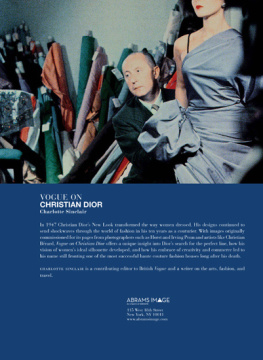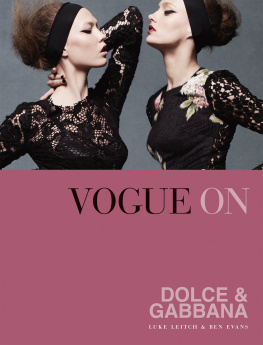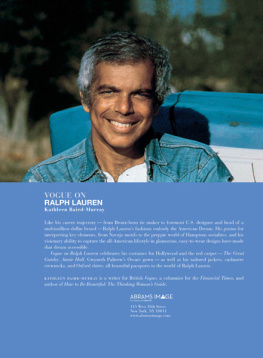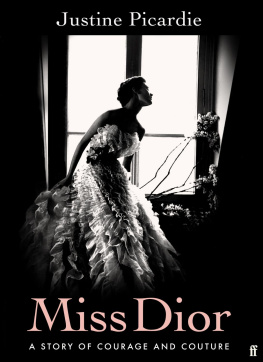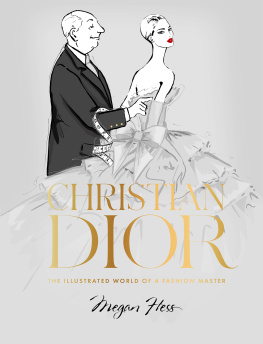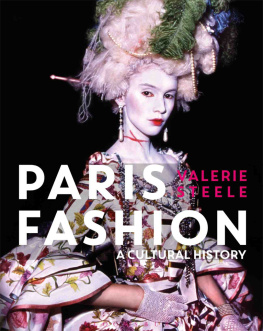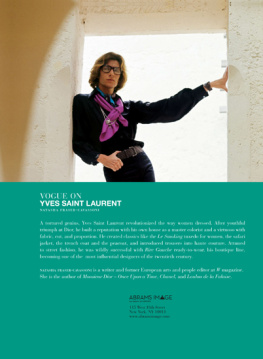
Diors monochromatic Mexique dress from 1951. Photograph Henry Clarke.


A Ren Bouch sketch of Diors 1949 cocktail dress with sweeping floor sash.

Dior photographed by Henry Clarke for Vogue with his favorite model, Rene, in 1957.
Contents
OF COURSE FASHION IS A TRANSIENT, EGOTISTICAL INDULGENCE, YET IN AN ERA AS SOMBRE AS OURS, LUXURY MUST BE DEFENDED CENTIMETRE BY CENTIMETRE.
CHRISTIAN DIOR
FORTUNES FAVOR
A
I F YOU CONJURED AN IMAGE of a fashion designer in your mind, you might not settle on one who looked like Christian Dior. A man with an air of baby plumpness still about him and an almost desperate shyness augmented by a receding chin as American Vogues Bettina Ballard recalled in 1946. Or the plump, balding bachelor of fifty-two whose pink cheeks might have been sculpted from marzipan, as described by Time reporter Stanley Karnow in 1957. The same sugary confection found its way into the great photographer Cecil Beatons account of Dior: a bland country curate made out of pink marzipan. Not that Christian Dior was unaware of the shortfall in his appearance. He wrote, I could not help thinking that I cut a sorry figure a well-fed gentleman in the Parisians favourite neutral-coloured suit compared with the glamour, not to say dandified or effeminate couturier of popular imagination. Dior was a man who knew what a legend should look like.
Photographed for Vogue on February 12, 1947the day his New Look was launched upon the worldDior is pictured dressed in sepulchral black, markedly glum, giving credence to his description in Life magazine as a French Undertaker. In the photograph the designer looks anything but legendary, anxiety writ large in the downturn of his mouth, in his distracted, sidelong gaze. But in fashion as in life, appearances can be deceptive. In every way that his looks were unmemorable and self-effacing, his fashions were not. Even his couture was a kind of trick, the lightest substance crafted upon the steeliest foundation. Surprise was one of Diors chief weapons and delights; he was an haute couturier whose clothes made all the fuss and fireworks that hedemure but utterly determinedtried to avoid.
Few designers in the history of fashion can be said to have changed the world in any way. But Christian Dior could faithfully make a claim to it. In only ten years at the house that bore his name, Dior revived Paris couture, bestowed a new business model upon fashion, and altered the visual language, so that his vision of how women should dressDiors taste and idealsbecame the accepted notion of fashion. It was the confidence with which he unleashed his ideas, the determination of his silhouettes, the sheer bravura of his visionthat this and nothing else was the look of the seasonthat secured his legacy.

On the eve of his February 1947 debut, Clifford Coffin photographs the new haute couturier, Christian Dior.
So too did his charm, his popularity, his keen embrace of publicity, and his construction of a public character that could be the mouthpiece for Maison Christian Dior. This personalitythe well-bred, avuncular couturier who called his fiercely loyal staff mes enfants, and whose rigorously high standards, in everything from food to flou, were built on a solid foundation of kindness and humanitywas arguably just as fundamental to the success of the house of Dior as his winning designs.
Equally, Diors keen commercial senserare in a designercreating licenses for the Dior name to be carried on everything from perfume to hosiery, ensured that everyone could buy into the Dior dream. Thus he dextrously balanced his work in the high-altitude world of couture with his ready-to-wear operations without debasing either sphere. By the time of his death in 1957, exactly ten years after his debut collection, Ballard wrote, The magic name of Dior stands for fashion to the masses. It is part of the taxi drivers vocabulary, the teenagers, and it is often the only name that rings a fashion bell in the mind of the average man.
And Vogue was there through it all, from New Look to H line, from corsetry to chemise. Front row in the pearl-gray salon of 30 Avenue Montaigne, Vogue bore witness to Diors developments of silhouette, reporting back from the crush and chaos of his twice-yearly collections, feeding an audience anxious to perceive Diors new direction: the shape of things to come.
I envisaged my house would be aimed at a clientele of really elegant women.
CHRISTIAN DIOR

At 30 Avenue Montaigne, the freshly minted house of Dior with its inimitable gray and white awnings.
P aris has reigned supreme as the crucible of haute couture since the nineteenth century. A French invention, couture couldnt exist anywhere else than here, in a city where fashion and the art of comme il fault have ever been a matter of national pride and civic duty. In Paris designers are lionized, treated as a sacred monster, a being apart wrote Cecil Beaton. Yet, as Dior keenly observed, they are kept firmly in check by a singularly difficult consumer the Parisienne.
Haute couture is a handcraft industry, a laboratory where beneath one roof, highly skilled flou (dressmaking) and tailleur (tailoring) ateliers create exquisite, made-to-measure clothing under the direction of their couturier. This rarefied process is enabled by myriad satellite artisans specializing in fine lacework, feathers, trims, beading, embroidery, and ribbon-making; and by fabric houses which source expensive, richly textured, and detailed materials from every corner of the earth. The stratified layers of an haute couture house equal the complex construction of their designs, where from couturier, to petit mains (seamstresses), vendeuses (saleswomen) to mannequins (models), modeliste (design assistant) to premiere (atelier head), everyone has a specific and vital role to play.
In 1939 there were seventy registered couture houses in Paris. We flitted from ball to ball under the surrealist presidency of Mme Schiaparelli, wrote Dior of the time. Fearing the inevitable cataclysm, we were determined to go down in a burst of splendour. Just seven years later, in 1947, everything had changed. Europe was wrecked by war and shattered by holocaust. France and Britain were working to rebuild and revive all that was lost or destroyed during the six years of the war, not least their national economies. Even two years after Germanys surrender, the roads that led out of Paris still bore the buckled and broken track marks of tank warfare. Haute couture was in a vastly diminished state. Severely curtailed during the Occupation, many couturiers like Chanel and Vionnet had simply closed. Others, like Schiaparelli and Mainbocher, had fled to New York. The few houses that were left functioning, including Fath, Balenciaga, and Lelong were subjected to fabric restrictions and were staffed with skeleton workforces. German officers had even attempted to shift haute couture entirely from Paris to Berlina move that would have destroyed the industrybut were persuaded against it by designer Lucien Lelong, then head of coutures governing body, the Chambre Syndicale.
Next page
